The History of Natural Gas: The Big Picture
Impactful Ninja is reader-supported. When you buy through links on our site, we may earn an affiliate commission.
Learn more
Learn more
.
Hey fellow impactful ninja ? You may have noticed that Impactful Ninja is all about providing helpful information to make a positive impact on the world and society. And that we love to link back to where we found all the information for each of our posts. Most of these links are informational-based for you to check out their primary sources with one click. But some of these links are so-called "affiliate links" to products that we recommend. First and foremost, because we believe that they add value to you. For example, when we wrote a post about the environmental impact of long showers, we came across an EPA recommendation to use WaterSense showerheads. So we linked to where you can find them. Or, for many of our posts, we also link to our favorite books on that topic so that you can get a much more holistic overview than one single blog post could provide. And when there is an affiliate program for these products, we sign up for it. For example, as Amazon Associates, we earn from qualifying purchases. First, and most importantly, we still only recommend products that we believe add value for you. When you buy something through one of our affiliate links, we may earn a small commission - but at no additional costs to you. And when you buy something through a link that is not an affiliate link, we won’t receive any commission but we’ll still be happy to have helped you. When we find products that we believe add value to you and the seller has an affiliate program, we sign up for it. When you buy something through one of our affiliate links, we may earn a small commission (at no extra costs to you). And at this point in time, all money is reinvested in sharing the most helpful content with you. This includes all operating costs for running this site and the content creation itself. You may have noticed by the way Impactful Ninja is operated that money is not the driving factor behind it. It is a passion project of mine and I love to share helpful information with you to make a positive impact on the world and society. However, it's a project in that I invest a lot of time and also quite some money. Eventually, my dream is to one day turn this passion project into my full-time job and provide even more helpful information. But that's still a long time to go. Stay impactful,Affiliate Disclosure
Why do we add these product links?
What do these affiliate links mean for you?
What do these affiliate links mean for us?
What does this mean for me personally?
![]()
Natural gas has grown more in the past decade than any other fossil fuel and accounts for approximately 25% of global electricity generation today. It is often referred to as a cleaner-burning fossil fuel than coal and oil. So we had to ask: What is the history of natural gas?
Natural gas (NG) energy began millions of years ago with the creation of fossil fuels. NG was initially produced from coal until NG wells were drilled in the 1800s. Then, the first NG pipelines were established in the 1900s. Today, NG is mainly used in industrial processes and as a heat source.
Keep reading to learn how natural gas came to be, who and what pioneered its development, how effective it has been thus far, and what the future of natural gas could entail.
Here’s the History of Natural Gas in a Nutshell
Natural gas is a flammable gas composed of predominantly methane (CH4), some hydrocarbon gas liquids (HGLs), and nonhydrocarbon gasses (carbon dioxide (CO2) and water vapor). It occurs in large quantities naturally below the Earth’s surface.
“Natural Gas: flammable gas, consisting largely of methane and other hydrocarbons, occurring naturally underground (often in association with petroleum) and used as fuel”
Oxford Dictionary
Commonly referred to as the world’s cleanest fossil fuel, natural gas is a flammable gas composed of mostly methane (CH4), some hydrocarbon gas liquids (HGLs), and nonhydrocarbon gasses (CO2 and water vapor). When burned, it produces mostly CO2, water vapor, and some nitrogen oxides. Natural gas is acquired in one of two ways, either by conventional (vertical) drilling or by hydraulic fracturing.
Natural gas has gone through three distinct development phases in its development:
- Early market formation and innovation: The early history of natural gas dates back millions of years ago when, under the right conditions, buried plant and animal remains were subjected to intense heat and pressure. Surface occurrences (natural seepages) of natural gas have been known since ancient times, and the first known natural gas well was drilled in 211 AD in China.
- Consolidation and strengthening: The modern history of natural gas first involved producing natural gas from coal and using it to light homes and streetlights. The drilling of natural gas wells began in the 1800s, and natural gas pipelines were first established in the 1900s.
- Mainstreaming: Following the invention of the Bunsen burner, natural gas began to establish itself as an alternative fuel to coal and oil. The establishment of the International Energy Agency (IEA) and International Renewable Energy Agency (IRENA), as well as the Global Methane Pledge of 2021, have since facilitated the transition away from natural gas and toward even cleaner forms of energy as the climate crisis continues to worsen.
| Natural Gas Milestones | Historical Event |
| Initial start | The early history of natural gas dates back millions of years when plant and animal remains gradually built up on the earth’s surface and the ocean floor. Under the right conditions, some remains were converted into natural gas. |
| Milestones in natural gas development | 1626: The usage of natural gas by Native Americans was first recorded in North America, near Lake Erie. 1659: Natural gas was first discovered in Europe in the Netherlands. 1785: The British used natural gas produced from coal to light homes and streets. 1816: The US used natural gas produced from coal to light streets in Maryland for the first time. 1821: William Hart drilled the first natural gas well in the US. Hart is widely known as the father of natural gas, later establishing the Fredonia Gas Light Company, the first natural gas company in the US. 1885: Robert Bunsen invented the Bunsen burner, which combined natural gas and air to produce a flame that could be used for cooking and heating. 1913: Romania constructed the first transport pipeline for natural gas, becoming one of the first countries in the world to use natural gas for industrial purposes. 1971: The South Pars/North Field gas field was discovered in Iranian and Qatari territorial waters. It remains the largest deposit of natural gas in the world. 2013: The Jebel Ali Power and Desalination Plant was opened. It remains the world’s largest, single-site natural gas power generation facility. 2021: The Global Methane Pledge was signed. It is an international agreement between over 100 member countries to reduce global methane emissions by 30% by 2030. |
| Current status | Currently, 23% of our primary energy comes from natural gas, and we consume almost 40,000 terawatt-hours (TWh) of natural gas energy a year. The top 10 largest natural gas-producing countries accounted for 73% of global natural gas global production. |
| Future outlook | The future of natural gas energy will be heavily influenced by ambitious government targets and policy support of reducing methane emissions, as well as increasing competitiveness and decreasing costs of renewable energies. |
| Key policy developments | 1974 – The International Energy Agency (IEA) 1995 – The International Hydropower Association (IHA) 2001 – World Nuclear Association (WNA) 2005 – Global Wind Energy Council (GWEC) 2009 – The International Renewable Energy Agency (IRENA) 2013 – Ocean Energy Europe (OEE) 2015 – International Solar Alliance (ISA) 2015 – Paris Climate Agreement 2021 – Global Methane Pledge |
Understanding natural gas’s history can provide insight into how it has evolved into the energy source it is today.
When and How Did Natural Gas Get Started
Natural gas energy comes from the combustion of natural gas, a fossil fuel.
Natural gas was formed millions of years ago when plant and animal remains gradually built up on the earth’s surface and the ocean floor, mixing with sand, silt, and calcium carbonate. Under immense heat and pressure, some of these remains were converted into natural gas depending on the combination of organic matter present, how long it was buried, and pressure conditions.
Surface occurrences (natural seepages) of natural gas have been known since ancient times. Some of the first natural gas seeps were discovered in Iran between 6000 and 2000 BC.
In 500 BC, the Chinese constructed extensive bamboo pipelines to transport gas used for boiling salt water into drinking water. In 211 AD, the first known natural gas well was drilled in China to a depth of 500 feet (150 meters).
How Has Natural Gas Developed Over Time
Fossil fuel consumption began with the Industrial Revolution, and consumption has increased exponentially over the past 70 years. In the 1900s, new technologies and environmental concerns forced a switch from solely coal to a mix of coal, oil, and natural gas.
What Are Milestones in Natural Gas Development
The modern history of natural gas involved producing natural gas from coal and using it to light homes and streetlights. The drilling of natural gas wells began in the 1800s, and natural gas pipelines began in the 1900s.
1626: French explorers discovered Native Americans in the US burning gasses found around Lake Erie. This was the first recorded discovery of natural gas in North America.
1659: The Groningen gas fields were discovered in the Netherlands, marking the first discovery of natural gas in Europe. At its peak, the Groningen fields produced 88 billion cubic meters of gas per year.
1785: The British used natural gas produced from coal to light homes and streets.
1816: The US used natural gas produced from coal to light the streets of Maryland, the first city in the US to do so.
1821: William Hart drilled the first natural gas well in the US. Hart is widely known as the father of natural gas, later establishing the Fredonia Gas Light Company, the first natural gas company in the US.
1885: Robert Bunsen invented the Bunsen burner, which combined natural gas and air to produce a flame that could be used for cooking and heating.
1913: Romania constructed the first transport pipeline for natural gas, becoming one of the first countries in the world to use natural gas for industrial purposes.
1971: The South Pars/North Field gas field was discovered in Iranian and Qatari territorial waters. It remains the largest deposit of natural gas in the world with a capacity of 1,800 trillion cubic feet.
2013: The Jebel Ali Power and Desalination Plant was opened. The oil and gas-fired plant is the world’s largest single-site natural gas power generation facility, with a 9,547 MW capacity.
2021: The Global Methane Pledge was established. It is an international agreement between over 100 member countries to reduce global methane emissions by 30% by 2030.
How Has the Natural Gas Market Developed Recently
The natural gas market has been turbulent following the COVID-19 pandemic in 2020 and Russia’s invasion of Ukraine in 2022.
2019: The global demand for natural gas grew by 1.8% (70 bcm) compared to 2018. We consumed 39,058 terawatt-hours (TWh) and produced 39,684 TWh of natural gas.
2020: The global demand for natural gas decreased largely as a result of the COVID-19 pandemic and ensuing global shutdowns. We consumed 38,603 TWh and produced 38,606 TWh of natural gas.
2021: The global demand for natural gas rebounded and surpassed 2019 levels. We consumed 40,670 TWh and produced 40,534 TWh of natural gas.
2022: The global demand for natural gas decreased partly due to Russia’s invasion of Ukraine, which led to skyrocketing prices. We consumed 39,413 TWh and produced 40,438 TWh of natural gas.
What Is the Present Status of Natural Gas
Natural gas has lagged far behind coal and oil as a source of energy for decades, but consumption has steadily grown since the 1960s. Natural gas can act as a cleaner replacement for coal in our energy mix, specifically as a source of heat.
We consumed 39,413 terawatt-hours (TWh) worth of natural gas in 2022, the least amount out of the fossil fuels.
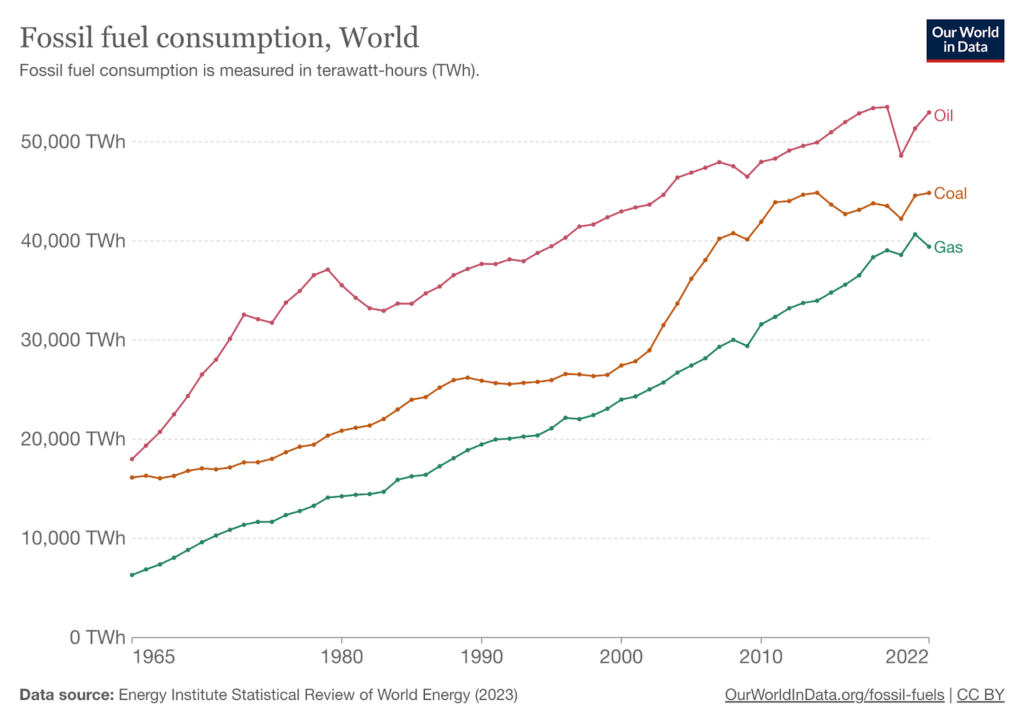
In 2022, natural gas accounted for roughly 23% of our primary energy, having grown from just over 15% in the 1960s.
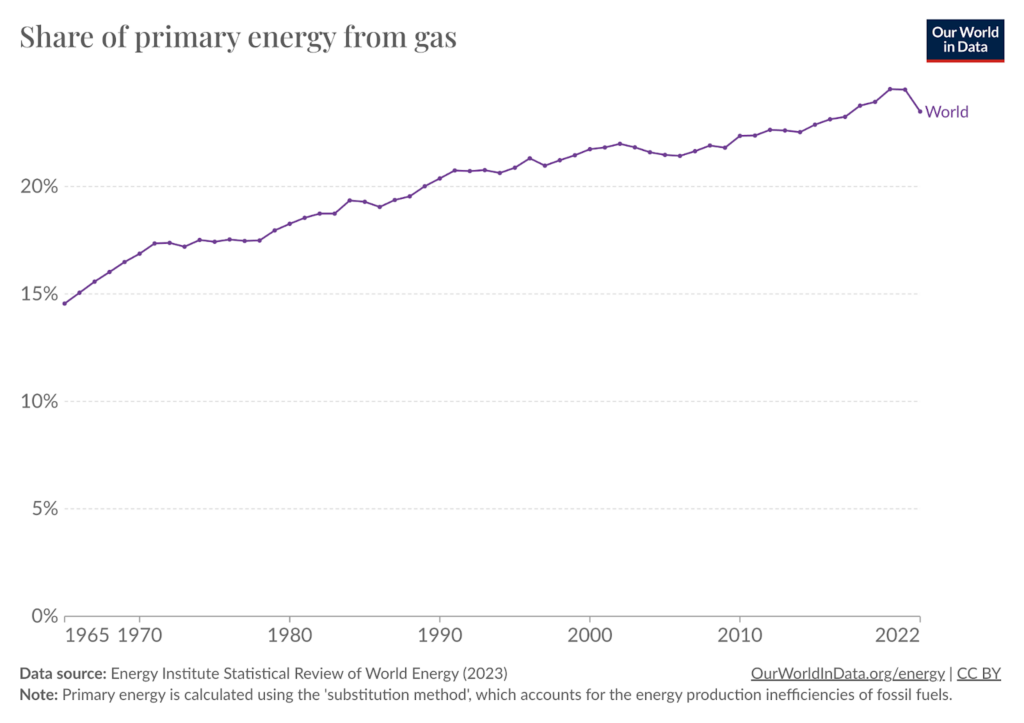
Global natural gas demand declined by 75 billion cubic meters (bcm) as a result of the COVID-19 pandemic. However, unlike the other fossil fuels, natural gas saw a quick recovery as lockdown measures were eased and seasonal electricity demand and competitive prices increased gas consumption. The recovery was, and still is, spurred by fast-growing markets in Asia and the Middle East.
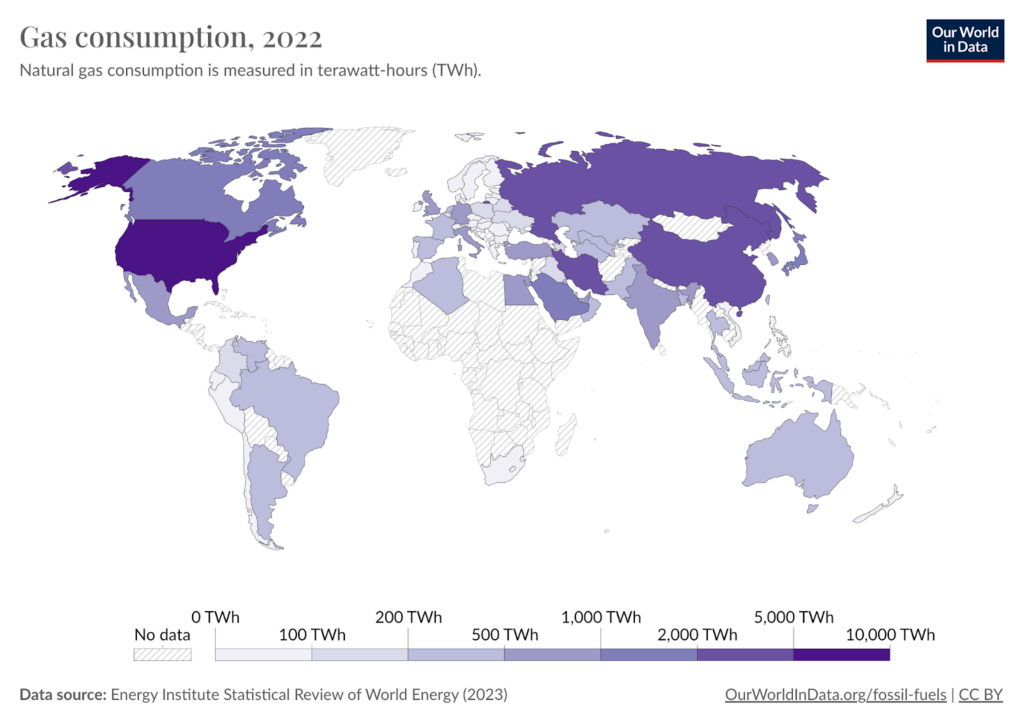
The top 5 natural gas-consuming countries (billion cubic meters (bcm) per year) in the world are:
- United States – 881 bcm
- Russia – 408 bcm
- China – 375 bcm
- Iran – 223 bcm
- Canada – 122 bcm
We produced 40,438 TWh worth of natural gas in 2022. The top 10 largest natural gas-producing countries, led by the US and Russia, accounted for 73% of global natural gas global production.
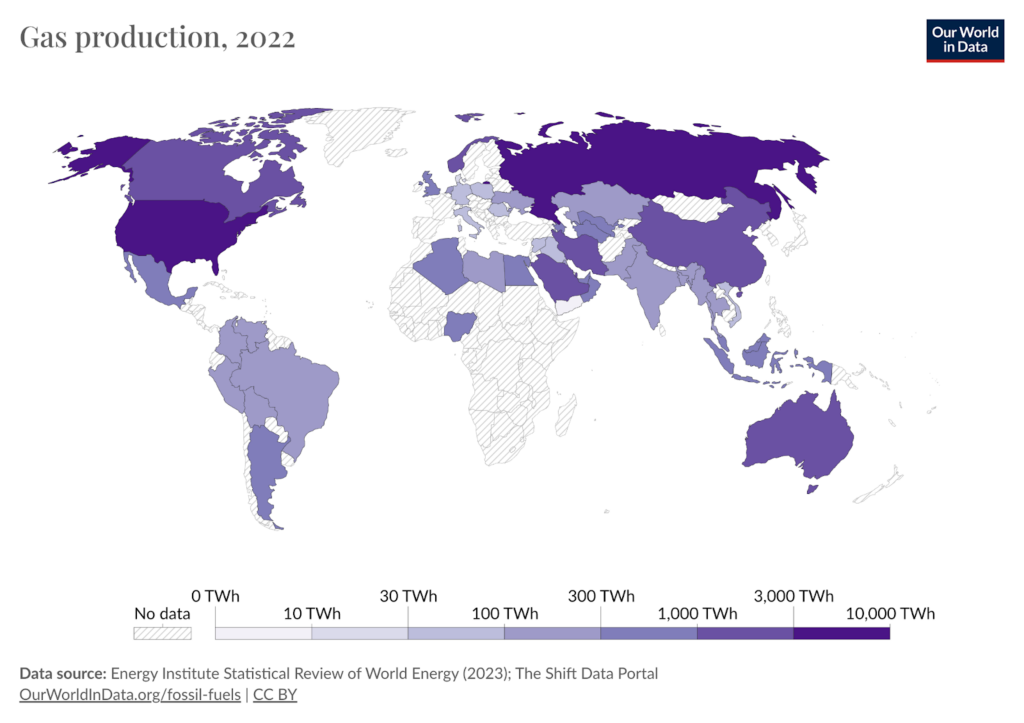
The top 5 natural gas-producing countries (bcm per year) in the world are:
- United States – 934 bcm
- Russia – 701 bcm
- Iran – 256 bcm
- China – 209 bcm
- Qatar – 177 bcm
In terms of greenhouse gas emissions, the world collectively emits roughly 7.92 billion tons of carbon dioxide (CO2) and 35 million tons of methane from natural gas.
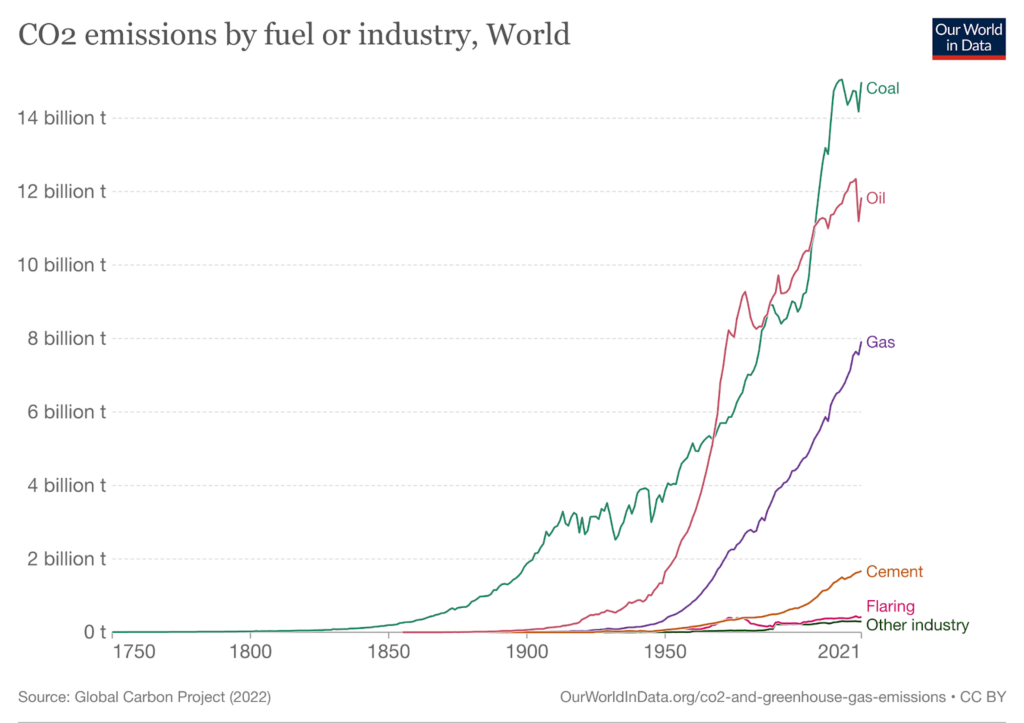
However, despite frequently being referred to as the cleanest fossil fuel, natural gas can also be a significant source of methane emissions. In 2022, natural gas accounted for roughly 30% of global methane emissions. Methane is 25 times more potent than CO2 at trapping heat in our atmosphere, so a little can go a long way.
How Will the Future of Natural Gas Look Like
Global natural gas markets are being affected by the ongoing war between Russia and Ukraine, which began in 2022. Ambitious government targets, policy support, and increasing competitiveness plus decreasing costs of renewable energies will heavily influence the future of natural gas energy.
How Natural Gas Will Likely Develop in the Future
In the short term, natural gas demand is predicted to increase by a total of 140 billion cubic meters (bcm) from 2021-2025. This is less than half of the amount forecasted previously and down from the 170 bcm increase in 2021 alone.
Record high gas prices resulting from the Russia-Ukraine war have forced the switch from natural gas to cheaper fuels, such as coal and oil, in some cases. Overall, the Asia-Pacific region is predicted to account for more than 50% of the growth in global gas demand through 2025, while the industrial sector could account for more than 60% of global demand.
In the long term, natural gas is the only fossil expected to grow beyond 2030. After peaking in 2037, natural gas demand is predicted to decline by roughly 0.5%. In general, natural gas used as power is predicted to gradually decline in Europe, Japan, and North America, whereas natural gas for industrial and chemical uses will grow past 2035.
The turmoil between Russia and Ukraine has cast doubt on natural gas’s future role as a transition fuel between fossil fuels (e.g., coal and oil) and renewable energy (e.g., solar, wind, hydropower).
Natural gas has long been seen as a transition fuel because it has a lower carbon footprint. On a life-cycle basis, natural gas emits 490 grams of CO2 equivalent per kWh, the third-highest amount out of all of the fuel types, but the lowest out of the three fossil fuels.

However, although natural gas is a cleaner-burning fossil fuel than both coal and oil, it still has environmental drawbacks that are important to understand:
- Air pollution: When natural gas is burned at well sites, it releases CO2, carbon monoxide (CO), sulfur dioxide (SO2), and nitrogen oxides into the atmosphere. Burning natural gas instead of releasing it directly into the atmosphere produces lower levels of GHG emissions because CO2 is not as potent as CH4, but it still contributes to the overall level of CO2 in our atmosphere.
- Drilling: This can disturb vegetation and soil and may require clearing and leveling the area around a well pad. Drilling also produces air pollution and may contaminate water sources via erosion, fracking fluids, equipment runoff, and sedimentation.
- Landscape alterations: Drilling for natural gas causes surface distribution from drill pads, roads, and pipelines that alter the landscape. Fragmentation of wildlife habitats and migration patterns have also been documented.
- Water pollution: Land clearing may cause dirt, minerals, and other pollutants to erode into nearby waterways. Drinking water may become contaminated with hazardous chemicals via drilling, fracturing, processing, and refining the gas, and wastewater disposal.
What Policies Are Put in Place to Reduce Natural Gas Usage
The most well-known piece of legally binding, international climate mitigation legislation is The Paris Agreement, the goal of which is to limit global warming to below 2 degrees Celsius (C), preferably to 1.5C, compared to pre-industrial levels.
The Paris Agreement specifically notes a transition away from fossil fuels (e.g., coal, oil, natural gas) and towards renewable energies (e.g., solar, wind, hydropower) as being a critical part of meeting these goals.
Check out the highlights of the 2015 COP21 directly from the UN Climate Change channel:
In addition, The International Energy Agency’s (IEA) Net Zero Emissions by 2050 Scenario is one framework for the global energy sector to achieve net zero CO2 emissions by 2050 and universal energy access by 2030.
One of the most prominent pieces of international legislation regarding natural gas is the Global Methane Pledge. In 2021, over 100 countries pledged to reduce global methane emissions at least 30% from 2020 levels by 2030. Because natural gas consists mostly of methane, reducing natural gas consumption would help to meet this goal.
There are many global and country-specific policies and organizations aimed at reducing fossil fuel usage, including natural gas, and meeting the 2050 net zero scenario, including:
- 1974 – The International Energy Agency (IEA): The IEA was founded in response to the major oil disruptions in 1974. It promotes international energy cooperation and is made up of 31 member countries.
- 1995 – The International Hydropower Association (IHA): The IHA is a nonprofit membership association that serves as a global voice for hydropower energy. They operate in over 120 countries and manage over 1/3rd of global installed hydropower capacity.
- 2001 – World Nuclear Association (WNA): The WNA was established as the leading international organization to represent the global nuclear energy industry.
- 2005 – Global Wind Energy Council (GWEC): The GWEC was founded as an international trade association for the wind energy industry. Their members represent 99% of the global installed wind power capacity.
- 2009 – The International Renewable Energy Agency (IRENA): IRENA was founded as a global intergovernmental agency focused on scaling renewable energy. It is comprised of 167 member countries as well as the European Union.
- 2013 – Ocean Energy Europe (OEE): They are the largest global network of marine energy professionals, with over 120 member organizations. They aim to advance tidal and wave energy technologies.
- 2015 – International Solar Alliance (ISA): The ISA is a treaty-based organization established to create cooperation among solar energy-resource-rich countries and the rest of the world. There are currently 94 member countries.
If you are interested in learning more about country-specific energy policies, you can visit the IEA’s policies database and filter by specific energy type.
What Are Currently the Different Types of Natural Gas
Conventional natural gas can be divided into two categories, both of which are used as vehicular fuels:
- Compressed natural gas (CNG): Produced by compressing natural gas to less than 1% of its volume at standard atmospheric pressure. It is used in light-, medium-, and heavy-duty applications and is stored at a pressure of up to 3,600 lbs per square inch.
- Liquified natural gas (LNG): Produced by purifying natural gas and cooling it to -260 degrees Fahrenheit (-162 Celsius). This removes the extraneous compounds in the fuel and reduces the volume of the fuel, leaving behind primarily methane and small amounts of other hydrocarbons and making it much easier to transport across long distances. It is used in medium- and heavy-duty vehicles but is not used as widely as CNG because of its high production, storage, and transportation costs.
Another form of natural gas is renewable natural gas (RNG), also referred to as biomethane. RNG is a pipeline-quality vehicle fuel generated by purifying biogas. Biogas is created via anaerobic digestion of organic materials (i.e. landfill and livestock waste) or thermochemical processes (i.e. gasification). RNG is chemically identical to conventional natural gas.
The easiest way to mitigate the environmental impact of natural gas is to simply not rely on it in the first place. But when this is not possible, there are ways to reduce natural gas’s environmental impact. And as a plus, its CO2 emissions are lower than that of coal and oil.
- Controlling CH4 leaks: Natural gas is considered the cleanest fossil fuel because it has lower levels of CO2, CO, nitrogen oxides, and SO2 than both coal and oil. However, these emissions and CH4 still contribute directly to global climate change. The best way to mitigate its environmental impact is to detect, fix, and repair CH4 leaks from well-pads, processing plants, compressor stations, and large distribution facilities. Doing this can reduce CH4 output by 1.70-1.80 million metric tons per year. Plugging abandoned natural gas wells also prevents the seepage of methane into the atmosphere.
- Prioritize renewable natural gas (RNG): RNG is biogas, the product of organic matter decomposition, that has been processed and purified. It can then be used as a transportation fuel in the form of compressed natural gas (CNG) or liquefied natural gas (LNG). Because there is no drilling or fracking, RNG has a lower carbon footprint than natural gas.
- Recycle water and use efficient production practices: Fracking uses a large amount of water, so recycling water and avoiding utilizing freshwater sources can reduce water requirements. Constructing wells properly and maintaining them after drilling is complete is crucial for efficiency.
- Implement practices that reduce the risk of induced seismicity: Fracking can cause seismic activity that leads to earthquakes. Avoiding water injection into active fault lines, limiting injection rates, installing seismic monitors, establishing a protocol for when seismic activity is induced, and abandoning wells with seismic activity are all ways to mitigate this threat.
Natural gas can be more efficient and environmentally friendly if certain protocols and environmental mitigation practices are followed.
Final Thoughts
The early history of natural gas dates back millions of years when, under the right conditions, buried plant and animal remains were subjected to intense heat and pressure. Surface occurrences (natural seepages) of natural gas have been known since ancient times, and the first known natural gas well was drilled in 211 AD in China.
The modern history of natural gas first involved producing natural gas from coal and using it to light homes and streetlights. The drilling of natural gas wells began in the 1800s, and natural gas pipelines were established in the 1900s.
Following the invention of the Bunsen burner, natural gas began to establish itself as an alternative fuel to coal and oil. In the 2000s, fears about climate change spurred policy that shifted away from fossil fuels and toward renewable energies. The establishment of the International Energy Agency (IEA) and International Renewable Energy Agency (IRENA) have helped to facilitate this transition.
Stay impactful,

Sources
- International Energy Agency: Gas
- US Energy Information Administration: Natural gas explained
- Connecticut Department of Energy and Environmental Protection: What is Natural Gas
- International Energy Agency: Homepage
- International Renewable Energy Agency: Homepage
- Global Methane Pledge: Homepage
- National Geographic: Natural Gas
- Britannica: Natural gas | Types, Discovery, Reserves, & Facts
- Our World in Data: CO2 emissions by fuel
- Energy Industry Review: Natural Gas – History and Modern Times
- Reuters: Netherlands to end Groningen gas production by Oct 1
- ProCon.org: Historical Timeline – Alternative Energy
- American Petroleum Institute: Where Does Natural Gas Come From?
- The NAtional News: UAE’s largest power and desalination plant opens at Jebel Ali
- Solar Power Guide: The Largest Power Plants in the World (Of All Types)
- Reuters: Factbox – Qatar, Iran share world’s biggest gas field
- Dubai Electricity & Water Authority: Jebel Ali Power and Desalination Complex enhances generation efficiency and meets energy and water demand in Dubai
- International Energy Agency: 2019: Cool down – Gas 2020 – Analysis
- Our World in Data: Gas consumption, 2022
- Our World in Data: Gas production
- Our World in Data: Fossil Fuels
- Our World in Data: Fossil fuel consumption, World
- Our World in Data: Share of primary energy from gas
- International Energy Agency: Natural gas – Global Energy Review 2021 – Analysis
- Visual Capitalist: Which Countries Produce the Most Natural Gas?
- Our World in Data: CO2 emissions by fuel
- US Environmental Protection Agency: Importance of Methane
- Our World in Data: CO₂ emissions by fuel or industry, World
- International Energy Agency: Global natural gas demand set for slow growth in coming years as turmoil strains an already tight market – News
- McKinsey: Global gas outlook to 2050
- World Nuclear Association: Carbon Dioxide Emissions From Electricity
- US Energy Information Administration: Natural gas and the environment
- Union of Concerned Scientists: Environmental Impacts of Natural Gas
- US Geological Survey: Landscape Effects of Oil and Gas Development
- The United Nations Framework Convention on Climate Change: The Paris Agreement
- International Energy Agency: Homepage
- International Energy Agency: Net Zero Emissions – Topics
- The International Hydropower Association: Homepage
- World Nuclear Association: Homepage
- Global Wind Energy Council: Homepage
- The International Renewable Energy Agency: Homepage
- Ocean Energy Europe: Homepage
- International Solar Alliance: Homepage
- US Department of Energy Efficiency and Renewable Energy: Alternative Fuels Data Center – Natural Gas Fuel Basics
- National Energy Technology Laboratory: 5.1. Gasification Introduction
- Business for Social Responsibility: Fuel Sustainability Brief – Natural Gas
- Natural Resources Defense Council: Reducing Natural Gas Leakage to Protect the Environment Is Easy to Do, Saves Money, and Creates Jobs
- Impactful Ninja: Natural Gas Energy Explained: All You Need to Know




 ® Fabrics? A Life-Cycle Analysis" itemprop="image" class="left" />
® Fabrics? A Life-Cycle Analysis" itemprop="image" class="left" />
